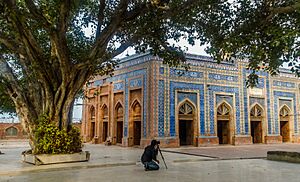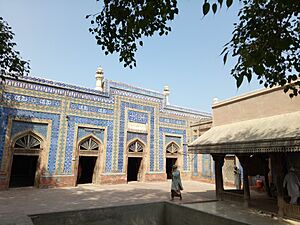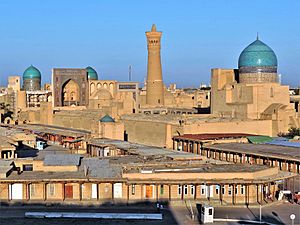Jalaluddin Surkh-Posh Bukhari facts for kids
Quick facts for kids
|
Jalaluddin "Surkh-Posh" Bukhari (Persian: سید جلال الدین سرخ پوش بخاری) was an important Sufi saint and a missionary who lived a long time ago. He was born around 1190 CE and passed away in 1295 CE. He belonged to a special group of Sufis called the Hussaini Jalali order. Many people respected him greatly for his teachings and his way of life.
Contents
His Many Names
Jalaluddin Bukhari was born as Jalaluddin Haider. His family name, Bukhari, comes from his birthplace, a city called Bukhara in what is now Uzbekistan.
He was often called Surkh-Posh, which means "clad in red." This was because he frequently wore a red cloak.
Over time, he received many other names and titles. Some of these include Jalal Ganj, Mir Surkh (Red Leader), Mir Buzurg (Big Leader), and Sher Shah (Lion King). People also called him Sayyid Jalaluddin and Pir Jalaluddin.
His Travels and Work
Jalaluddin Bukhari spent much of his life traveling. He was an Islamic missionary, which means he traveled to share the teachings of Islam. He helped many tribes, like the Soomro, Samma, Chadhar, Sial, Daher, and Warar, learn about Islam.
He was part of a group called the Chaar Yaar. These were pioneers of the Suhrawardiyya and Chisti Sufi movements in the 13th century. Bukhari also started his own special group, known as the "Jalali" order.
Some of his followers, called mureed, traveled to other places like Gujarat. One of his famous grandsons, Jahaniyan Jahangasht, visited Mecca many times. In 1134 CE, some of Bukhari's followers, the Sial tribe, settled in the area that is now Jhang. Many of his students are buried in places like Banbhore and Makli Hill in Pakistan.
Famous Meetings
Jalaluddin Bukhari met several important people during his life:
Meeting the Sultan of Delhi
When Jalaluddin Bukhari began his missionary work in Uch Shareef, he was visited by Nasiruddin Mahmud, who was the Sultan of the Delhi Sultanate.
Meeting Shah Daulah Shahid
He gave a pair of gray pigeons to a Muslim saint named Shah Daulah Shahid in Bukhara. Saint Daulah later traveled to Bengal.
Meeting Lalla
One of Bukhari's female students was Lalleshwari (also known as Lal Ded). She met his descendant, Jahaniyan Jahangasht, and was very impressed by him. She traveled with him in Kashmir.
Meeting Chengiz Khan
Legend says that on his way to India, Bukhari met Genghis Khan, the famous Mongol leader. Bukhari tried to teach him about Islam, but Genghis Khan did not convert.
His Final Resting Place
Around 1244 CE, Bukhari moved to Uch, a town in South Punjab, which is now called Uch Sharif. He started a religious school there with his son, Baha-ul-Halim. He passed away around 1292 CE and was buried in a small town near Uch.
His first tomb was damaged by floods. So, his remains were moved to a town called Qattal. Later, in 1027 AH, his remains were moved again to their current spot in Uch. A building was built over them. In the 1770s CE, the tomb was rebuilt by the Nawab of Bahawalpur.
The tomb is close to the cemetery of Uch. It sits on a high spot overlooking the plains and the desert. Next to the tomb is a mosque with beautiful blue tiles. In front of the tomb, there is a pool. A carved wooden door leads into the room where Bukhari's coffin is.
UNESCO describes the site as a brick building, 18 meters by 24 meters. It has carved wooden pillars that hold up a flat roof. The building is decorated with colorful tiles in flower and geometric patterns. The ceiling has painted flower designs, and the floor is covered with the graves of the saint and his family.
Mela Uch Sharif
The Mela Uch Sharif is a week-long festival held in March or April in Uch. People from southern Punjab come to honor Bukhari for his important role in spreading Islam. During the festival, people visit Bukhari's tomb and offer prayers at the local mosque. This festival celebrates the gathering of Sufi saints connected to Bukhari.
His Family
Jalaluddin Bukhari was born in Bukhara, in what is now Uzbekistan. His father was Syed Ali Al-Moeed. Bukhari received his early education from his father.
His Wives and Children
Bukhari had three wives. His first wife was Syeda Fatima. They had two sons, Ali and Ja’far, who are buried in Bukhara. After Fatima passed away, Bukhari moved to Bhakkar, Punjab, with his two sons.
In Bhakkar, he married Bibi Tahirah, also known as Zohra. She was the daughter of Syed Badruddin Bhakkari. Zohra and Bukhari had two sons: Sadruddin Mohammed Ghaus and Bahauddin Mohamed Masoom. Their descendants now live in places like Thatta, Uch, and Lahore.
After Zohra's death, Bukhari married her sister, Bibi Fatima Habiba Saeeda. They had a son named Ahmed Kabir. Ahmed Kabir was the father of Jahaniyan Jahangasht.
His Ancestors and Descendants
Many books tell the story of Bukhari's life and his family history. Some of these books are Marat-e-Jalali and Mazher-i-Jalali. His descendants are known as Naqvi al-Bukhari. The part of Uch where his family settled is even called "Uch Bukharian."
Many of his descendants became saints and religious leaders. Some moved to Turkestan, and others went to Bursa in Turkey. Some also moved to different parts of Pakistan and India. For example, there is a famous mosque in Kannauj named after Bukhari's son, Makhdoom Jahaniyan Jahangasht.
In the Kurram Agency, a descendant named Syed Pahlawan Shah Bukhari was a well-known scholar. He worked to spread peace and education among the people. He also stood against the British rulers in the area.
There are many tombs of Bukhari's descendants across different regions. These include the tomb of Jahaniyan Jahangasht and the tomb of Bibi Jawindi, who was Bukhari's great-granddaughter. The tomb of Bibi Jawindi and the tomb and mosque of Jalaluddin Bukhari are considered important historical sites by UNESCO.
Jalaluddin Surkh-Posh Bukhari also had a son named Syed Ahmad Kabir who moved to Mecca. Kabir's sister, Syeda Haseenah Fatimah, was the mother of Shah Jalal, another famous saint.
Family Tree
Here is a simplified list of Jalaluddin Bukhari's family line, going back to very important figures in Islamic history:
- Jalaluddin Haydar Surkh-Posh Bukhari
- Ali al-Moeed
- Ja’far Husayn
- Muhammad Abul Fateh
- Mahmud
- Ahmad
- Abdullah
- Ali Ashghar
- Ja'far Sani
- Ali al-Hadi
- Muhammad al-Jawad
- Ali al-Ridha
- Musa al-Kadhim
- Ja'far al-Sadiq
- Muhammad al-Baqir
- Ali ibn Husayn Zayn al-Abidin
- Husayn ibn Ali
- Ali ibn Abi-Talib
See also
- Sharfuddin Shah Wilayat
- List of mausolea and shrines in Pakistan
- Syed
- Bukhari




